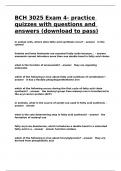Bch 3025 - Study guides, Class notes & Summaries
Looking for the best study guides, study notes and summaries about Bch 3025? On this page you'll find 39 study documents about Bch 3025.
All 39 results
Sort by
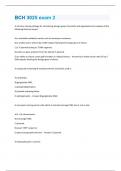
-
BCH 3025 exam 2 Questions And Answers Graded A+
- Exam (elaborations) • 41 pages • 2024
- Available in package deal
-
- $7.99
- + learn more
A common cloning strategy for introducing foreign genes into plants with Agrobacterium employs all the following features except: A) a selectable antibiotic marker such as kanamycin resistance. B) a shuttle vector with 25 bp T-DNA repeats flanking the foreign gene of choice. C) a Ti plasmid lacking its T-DNA segment. D) active vir gene products from the altered Ti plasmid. E) an ability to induce crown gall formation in infected leaves. - Answer-B) a shuttle vector with 25 bp TDNA repeats ...
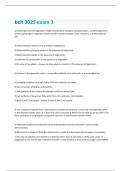
-
bch 3025 exam 3 Questions & Answers Already Passed!!
- Exam (elaborations) • 66 pages • 2024
- Available in package deal
-
- $7.99
- + learn more
2,4-Dinitrophenol and oligomycin inhibit mitochondrial oxidative phosphorylation. 2,4-Dinitrophenol is an uncoupling agent; oligomycin blocks the ATP synthesis reaction itself. Therefore, 2,4-dinitrophenol will: A) allow electron transfer in the presence of oligomycin. B) allow oxidative phosphorylation in the presence of oligomycin. C) block electron transfer in the presence of oligomycin. D) diminish O2 consumption in the presence of oligomycin E) do none of the above. - Answer-A) allow...
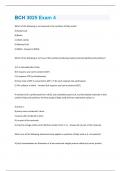
-
BCH 3025 Exam 4 Questions And Answers Graded A+
- Exam (elaborations) • 83 pages • 2024
- Available in package deal
-
- $7.99
- + learn more
Which of the following is not required in the synthesis of fatty acids? A) Acetyl-CoA B) Biotin C) HCO3- (CO2) D) Malonyl-CoA E) NADH - Answer-E) NADH Which of the following is not true of the reaction producing malonyl-CoA during fatty acid synthesis? A) It is stimulated by citrate. B) It requires acyl carrier protein (ACP). C) It requires CO2 (or bicarbonate). D) One mole of ATP is converted to ADP + Pi for each malonyl-CoA synthesized. E) The cofactor is biotin. - Answer-B) It requ...
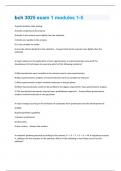
-
bch 3025 exam 1 modules 1-5 Questions And Answers Graded A+
- Exam (elaborations) • 42 pages • 2024
- Available in package deal
-
- $7.99
- + learn more
A good transition-state analog: A) binds covalently to the enzyme. B) binds to the enzyme more tightly than the substrate. C) binds very weakly to the enzyme. D) is too unstable to isolate. E) must be almost identical to the substrate. - Answer-binds to the enzyme more tightly than the substrate. A major advance in the application of mass spectrometry to macromolecules came with the development of techniques to overcome which of the following problems? A) Macromolecules were insoluble i...
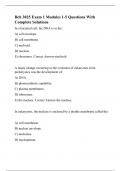
-
Bch 3025 Exam 1 Modules 1-5 Questions With Complete Solutions
- Exam (elaborations) • 58 pages • 2024
-
- $13.99
- + learn more
In a bacterial cell, the DNA is in the: A) cell envelope. B) cell membrane. C) nucleoid. D) nucleus. E) ribosomes. Correct Answer-nucleoid A major change occurring in the evolution of eukaryotes from prokaryotes was the development of: A) DNA. B) photosynthetic capability. C) plasma membranes. D) ribosomes. E) the nucleus. Correct Answer-the nucleus. In eukaryotes, the nucleus is enclosed by a double membrane called the: A) cell membrane. B) nuclear envelope. C) nu...
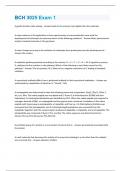
-
BCH 3025 Exam 1 Questions With Correct Answers!!
- Exam (elaborations) • 14 pages • 2024
- Available in package deal
-
- $7.99
- + learn more
A good transition-state analog: - Answer-binds to the enzyme more tightly than the substrate A major advance in the application of mass spectrometry to macromolecules came with the development of techniques to overcome which of the following problems? - Answer-Mass spectrometric analysis involved molecules in the gas phase A major change occurring in the evolution of eukaryotes from prokaryotes was the development of: - Answer-the nucleus A metabolic pathway proceeds according to the schem...
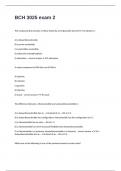
-
BCH 3025 exam 2 questions and answers A+ rated
- Exam (elaborations) • 42 pages • 2024
- Available in package deal
-
- $22.99
- + learn more
BCH 3025 exam 2 questions and answers A+ rated

-
bch 3025 exam 1 modules 1-5 Questibch 3025 exam 1 modules 1-5 Questions with Complete Correct Answers | Grade A+ons with Complete Correct Answers | Grade A+
- Exam (elaborations) • 69 pages • 2024
-
- $16.99
- + learn more
In a bacterial cell, the DNA is in the: A) cell envelope. B) cell membrane. C) nucleoid. D) nucleus. E) ribosomes. Ans: nucleoid A major change occurring in the evolution of eukaryotes from prokaryotes was the development of: A) DNA. B) photosynthetic capability. C) plasma membranes. D) ribosomes. E) the nucleus. Ans: the nucleus. In eukaryotes, the nucleus is enclosed by a double membrane called the: A) cell membrane. B) nuclear envelope. C) nucleolus. D) nucleopl...
BCH 3025 Exam 4- practice quizzes with questions and answers (download to pass)
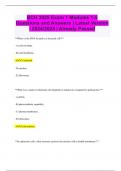
-
BCH 3025 Exam 1 Modules 1-5 Questions and Answers | Latest Version | 2024/2025 | Already Passed
- Exam (elaborations) • 67 pages • 2024
-
- $11.60
- + learn more
BCH 3025 Exam 1 Modules 1-5 Questions and Answers | Latest Version | 2024/2025 | Already Passed **Where is the DNA located in a bacterial cell?** - A) cell envelope. - B) cell membrane. - C) nucleoid. - D) nucleus. - E) ribosomes. **What was a major evolutionary development in eukaryotes compared to prokaryotes?** - A) DNA. - B) photosynthetic capability. - C) plasma membranes. - D) ribosomes. - E) the nucleus. **In eukaryotic cells, what structure encloses the nucleus...

That summary you just bought made someone very happy. Also get paid weekly? Sell your study resources on Stuvia! Discover all about earning on Stuvia



